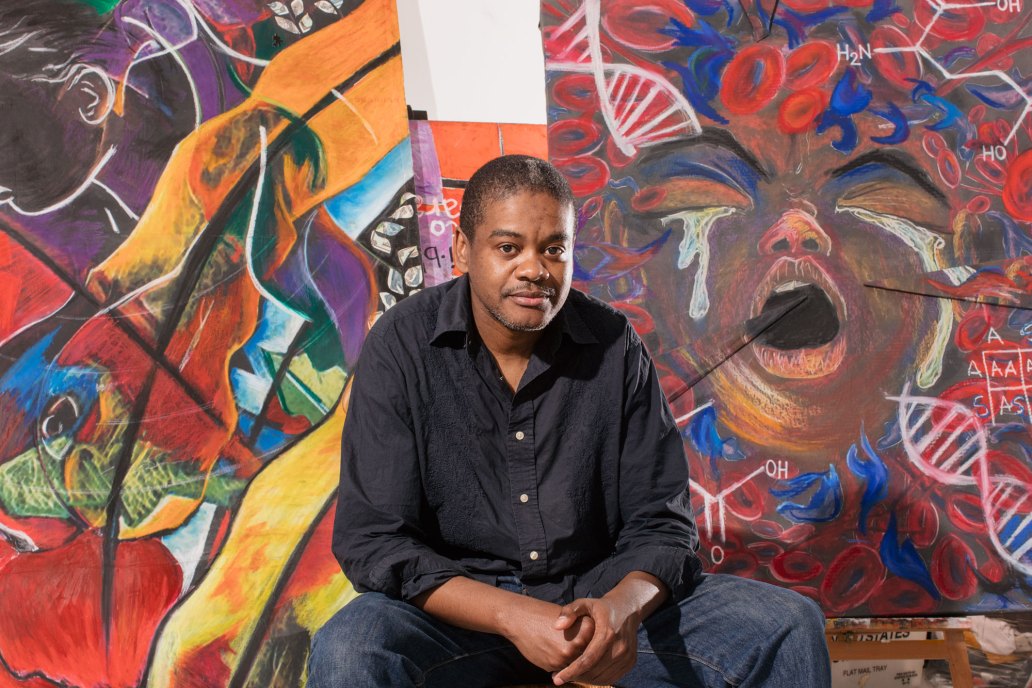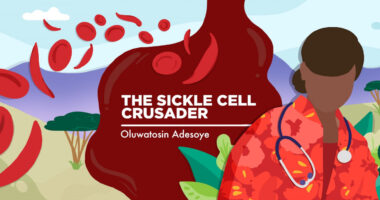Artist Has Vision to Open People’s Minds to Sickle Cell Disease

Photo courtesy of Global Blood Therapeutics
Hertz Nazaire sits in front of his paintings in his home workspace.
Note: This story was updated July 7, 2021, to clarify that Hertz Nazaire lived with his godmother, rather than his grandmother, after his mother’s death.
A Connecticut-based artist living with sickle cell disease and blindness in his right eye is using his art to advocate for the sickle cell community and help people understand and empathize with those with the disorder.
“There was a lot of stigma surrounding my disease, getting kicked out from hospitals because they didn’t believe I had the pain or believe I had sickle cell,” said 47-year-old Hertz Nazaire in a Zoom interview with Sickle Cell Disease News. “It pushed me to try to use my art and show what my pain felt like.”
One of Nazaire’s more recent creations, called the Waiting Chair project, addresses some of the stigmas faced by people with sickle cell disease and the long waits they must endure in the emergency room to get care. He printed three of his art pieces on the fabric of three chairs to represent the reality of some patients having to wait up to 12 hours before they are treated.
“Many places [emergency rooms] are ignorant about what sickle cell is and what it does to the body,” Nazaire said. “We’re not here for drugs to get high; we’re here because we are in danger of dying, because this thing is deadly.”
Nazaire submitted his project to the Holman Prize for Blind Ambition, which awards $25,000 to three blind or visually impaired people “with ideas that will transform perceptions about blindness worldwide,” according to its website. Nazaire made the semifinals, but fell short of winning the prize.
Because he is completely blind in his right eye and can’t see well out of his left, Nazaire creates large paintings, though he sells smaller prints of them online. The art related to his sickle cell experience mixes elements of his Haitian culture, with themes of blood, pain, and hope.
One of his paintings is featured on the cover of a McGraw-Hill medical textbook, “Sickle Cell Disease.” He is also working on a mural for the lobby of the U.S. office of Global Blood Therapeutics, the pharmaceutical company that makes Oxbryta (voxelotor), a medication Nazaire uses, which targets the underlying cause of cell sickling.
While World Sickle Cell Day on June 19 has passed, Nazaire said advocating for people with the disease through his art platform and life experience never stops.
“Sickle cell advocacy is whenever somebody is willing to listen,” he said. “It’s every day; it’s the kind of thing that never goes away.”
He’s not the only voice out there, Nazaire added, and sometimes has to work against conflicting ideas in the community. For example, some caregivers use the word “sickler” to describe people with the disease. Even though Nazaire thinks the word is negative, he hears people, including some patients who grew up around the word, still use it. Nazaire believes that is counterproductive.
“I advocate for mental health and staying away from negative words and negative circumstances,” he said. “People get into fights because of the word, and it’s not a positive environment for care if you’re both at each other’s throats.”
Art has always been part of Nazaire’s life. Growing up in Haiti, he was used to seeing colorful buildings, cars, and clothing. When he moved in with his mom in New York City as an 8-year-old, and eventually Connecticut in the ’80s, he would draw pictures of his mom’s stuff and create “I love you” messages as a mode of communication because he was often too shy to speak.
“I just wanted to tell her I appreciate her,” Nazaire said, especially because she was often taking him to the hospital for his sickle cell flare-ups. “I used my art to say it instead of words.”
His mother, Yvesrose Nazaire, died in a car accident just before Nazaire’s 14th birthday. He moved into his stepfather’s house, eventually became a ward of the state because he wasn’t being taken care of, and was placed with his godmother until he turned 18.
After Nazaire’s 18th birthday, his godmother told him he had to leave, and he entered his first bout of homelessness for eight months in late 1995 until he went off to the University of Bridgeport in Stamford, Connecticut, and found a place to stay there. But two years later, because he was so frequently ill and needed to move closer to Bronx, New York, for better care, he was forced to drop out of school.
Nazaire has held jobs at McDonald’s, Blockbuster, Brookstone, and various department stores. However, the pain and exhaustion from sickle cell forced him out of work. While it’s illegal to fire someone based on a disability, Nazaire said management kept reducing his hours after his long hospital stays, pushing him out slowly.
“I just kept trying. I didn’t want to be on disability. I didn’t want to give up,” Nazaire said. “It was really difficult out there, especially with sickle cell.”
So in 1998, Nazaire was homeless for the second time. This time, he stayed in Central Park for about a month and then in Florida, where the weather is warmer and better for sickle cell patients, for four months. He returned to Bridgeport for another eight months at a halfway house. In 2004, he became homeless for the third and final time while he waited for his current rent-controlled artist space to be completed.
Nazaire has lived in his current home since December 2004 and is now accepting disability payments. While he makes a modest amount of money selling his art and getting support through the online creator platform Patreon, most of his time is spent managing his health.
Though Nazaire has applied to participate in various gene therapy trials, he’s been turned down because either he is too healthy to need treatment or he is too old. He stressed that gene therapy is not a cure for everyone, and there’s still more work to do.
“There’s going to be generations and generations of young people who are never going to have access to a cure,” Nazaire said. “We have to still provide them with the help they need.”







